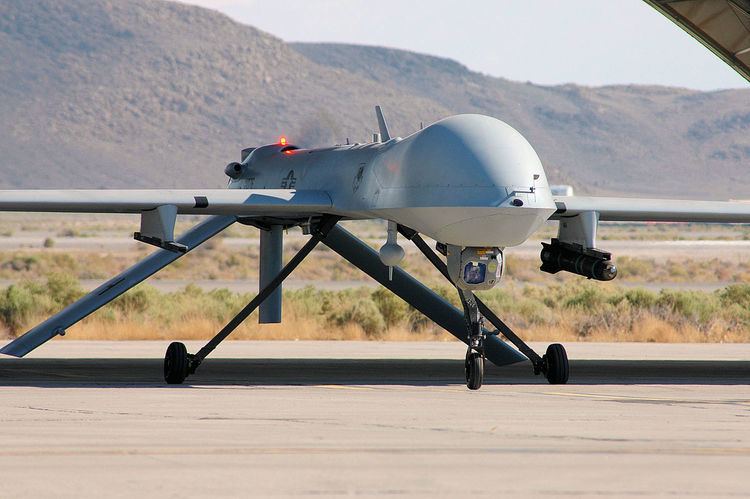Active 9 May 1917 Garrison/HQ Creech Air Force Base | Country United States | |
 | ||
Branch United States Air Force Size over 140 combat-ready personnel Part of Air Combat Command
Twelfth Air Force
432d Wing
432d Operations Group | ||
15th Reconnaissance Squadron (15 RS) flies MQ-1 Predator UAV's and is stationed at Creech Air Force Base in Indian Springs, Nevada. The 15th Reconnaissance Squadron is one of the first armed Remotely Piloted Aircraft (RPA) squadrons. The squadron provides combatant commanders with persistent ISR, full-motion video, and precision weapons employment. Global operations architecture supports continuous MQ-1B Predator employment providing real-time actionable intelligence, strike, interdiction, close air support, and special missions to deployed war fighters.
Contents
Mission
The 15th Reconnaissance Squadron is currently in operation at Indian Springs Air Force Auxiliary Field, Nev., and is the second of only two of the Air Force’s RQ-1 Predator unmanned aerial vehicle, or UAV, squadrons.
The mission of the 15 RS is to provide theater commander with deployable, long endurance, near real-time reconnaissance, surveillance and target acquisition to close the sensor-to-shooter time line. The squadron operates medium altitude multi-sensor platforms to locate, identify and report battlefield conditions to warfighters. It also collects, exploits and distributes imagery and intelligence products to theater CINCs and national-level leadership.
History
The 15th Reconnaissance Squadron's origins go back to 8 May 1917, when it was stood up as the 2d Aviation School Squadron at Hazelhurst Field, Long Island, New York. The original mission of the squadron was part of the defense force for the New York City area, flying coastal patrols and as a flying training unit. At the end of World War I, the squadron was demobilized on 18 September 1919.
The squadron was constituted in the Army Air Service as the 15th Squadron (Observation) on 14 March 1921 at Chanute Field, Illinois, equipped with Dayton-Wright DH-4s. the main focus of the squadron was flying training, including gunnery, observation, reconnaissance, photography, radio familiarization and similar missions.
On 20 March 1938, the 15th Observation Squadron deployed from Scott Field, Illinois, to Eglin Field, Florida, for two weeks of gunnery training. Thirty-five officers and 108 enlisted men were involved.
During the early stages of World War II, the 15th supported the Field Artillery School in Oklahoma. On March 26, 1944, the unit deployed to England and began combat operations over France. Its first combat mission was photographic reconnaissance on an F-6. On June 6, 1944, the 15th received credit for the first aerial victory by a tactical reconnaissance pilot as well as the first victory of D-Day. The unit continued armed reconnaissance operations in the European theater until July 1945. After returning to the United States, the squadron provided visual and photographic reconnaissance and artillery adjustments for Army, Navy and Air Forces until it was inactivated in April 1949.
The 15th Tactical Reconnaissance Squadron, Photo-jet, was reactivated on Feb 5, 1951, in Japan and immediately deployed to Korea to provide visual and photographic reconnaissance. The unit flew F/RF-80s and F/RF-85s during this period. In March 1954 the unit moved back to Japan and in August 1956, moved to Okinawa. The unit transitioned to RF-84s from 1956-1958 and then to the RF-101s, continuing its long history of photographic reconnaissance. During the Vietnam era the 15th Tactical Reconnaissance Squadron was based at Kadena Air Base, Okinawa, flying the RF-101. The unit had many deployments to Southeast Asia, flying reconnaissance missions in support of US combat operations in that theatre. During the summer and fall of 1966, the squadron transitioned to the RF-4C, the aircraft that it was to operate for the next 25 years.
During the 1970s and 1980s, the squadron maintained aerial surveillance capabilities in support of American ground, naval and air forces in the Far East. The 15th Tactical Reconnaissance Squadron was inactivated Oct. 1, 1990. The unit was reactivated as the 15th Tactical Intelligence Squadron on Feb. 20, 1991. On April 13, 1992, the unit was redesignated as the 15th Air Intelligence Squadron. On June 1, 1994, it was once more inactivated.
The unit was reactivated on 1 August 1997, at Indian Springs Air Force Auxiliary Field under command of the 57th Operations Group, 57th Wing. It was assigned to fly the Predator UAV out of Indian Springs Air Force Auxiliary Field, Nevada.
From July 2005 to June 2006, the 15th Reconnaissance Squadron participated in more than 242 separate raids; engaged 132 troops in contact-force protection actions; fired 59 Hellfire missiles; surveyed 18,490 targets; escorted four convoys; and flew 2,073 sorties for more than 33,833 flying hours.
Starting in 2005, the unit trained California Air National Guard's 163d Reconnaissance Wing members to operate the MQ-1.The 163d is being retasked as an MQ-1 unit.
Lineage
Assignments
Aircraft
Emblem
A carrier pigeon in natural colors with wings extended perched on a telescope white outlined in black upon a shield of blue and yellow parted diagonally from "northwest" to "southeast", the blue above, the yellow below. Approved 2 April 1924
